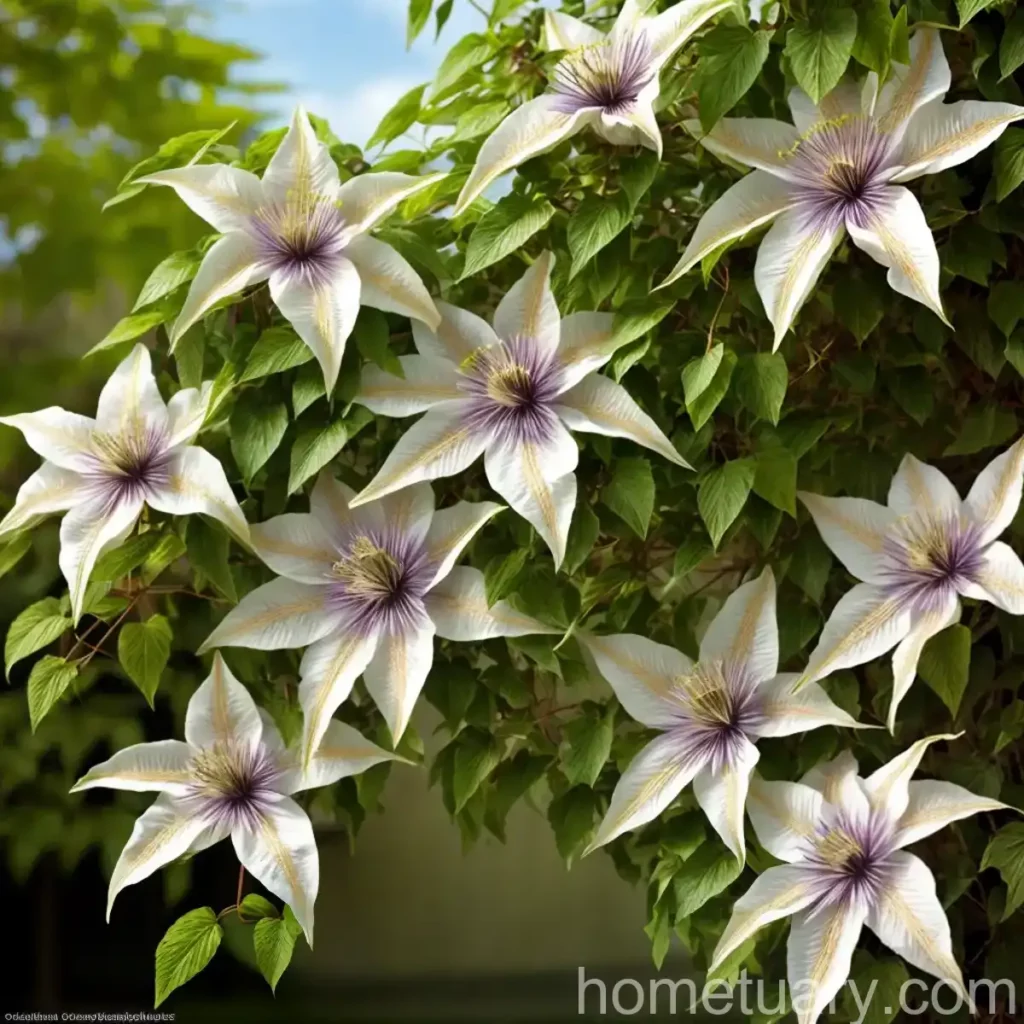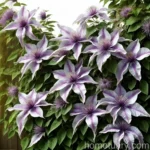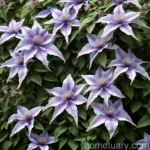Plant Scientist’s Guide: Golden-bell Clematis (Clematis tangutica)
The world of plants is a rich tapestry of diversity, offering an array of colors, scents, and forms. Among these, the golden-bell clematis (Clematis tangutica) stands out with its vibrant yellow flowers and climbing habits. As a plant scientist with a passion for horticulture, I am excited to delve into the deep-rooted world of the golden-bell clematis. In this comprehensive guide, we will explore its characteristics, cultivation tips, care requirements, common pests and diseases, and much more. Let’s embark on a fascinating journey into the realm of Clematis tangutica.
What is Plant :Golden-bell Clematis (Clematis tangutica)
The golden-bell clematis, scientifically known as Clematis tangutica, is a deciduous perennial vine that hails from the mountainous regions of Asia, particularly China and Tibet. It is a member of the Ranunculaceae family, which includes around 300 species within the Clematis genus. This charming vine is celebrated for its distinctive golden-yellow, bell-shaped flowers that gracefully adorn gardens and landscapes.
Key Takeaways – Golden-bell Clematis (Clematis tangutica)
Before we delve deeper into the world of golden-bell clematis, let’s highlight some key takeaways that we will explore throughout this guide:
- Clematis tangutica Characteristics
- Golden-bell Clematis Varieties
- Clematis tangutica Cultivation Tips
- How to Grow Golden-bell Clematis
- Best Soil for Clematis tangutica
- Clematis tangutica Care Guide
- Golden-bell Clematis Pruning Techniques
- Clematis tangutica Trellis Support
- Growing Golden-bell Clematis in Containers
- Clematis tangutica Pests and Diseases
- Golden-bell Clematis Propagation Methods
- Clematis tangutica Flowering Season
- Golden-bell Clematis Climbing Habits
- Clematis tangutica Sun Requirements
- Golden-bell Clematis Hardiness Zones
- Clematis tangutica Water Needs
- Golden-bell Clematis Companion Plants
- Clematis tangutica Wildlife Attraction
- Golden-bell Clematis in Landscape Design
- Clematis tangutica Color Variations
Now, let’s embark on an insightful journey through the world of golden-bell clematis, exploring its culture, uses, and much more.
Culture
The culture of golden-bell clematis extends beyond its physical attributes and encompasses its historical significance, traditional uses, and folklore beliefs. Let’s explore the cultural aspects associated with this captivating vine.
Historical Significance
Clematis tangutica holds historical significance in the regions where it naturally occurs. Local cultures often incorporate the plant’s vibrant flowers and climbing habits into traditional ceremonies and folklore. In some cultures, it is believed that the golden-bell clematis symbolizes luck, prosperity, and longevity. Additionally, historical records may reveal the use of golden-bell clematis in traditional medicine, indicating its value as a medicinal plant in certain cultures.
Traditional Uses
An important aspect of a plant’s culture is its traditional uses. In the case of Clematis tangutica, historical communities may have utilized various parts of the plant for medicinal, ornamental, or practical purposes. Understanding the traditional uses of golden-bell clematis provides valuable insights into the plant’s role in local ecosystems and human societies.
Folklore Beliefs
Throughout history, plants have often been entwined with folklore and myths. The golden-bell clematis may have inspired tales and beliefs, becoming an emblem of resilience, beauty, or transformation in folklore traditions. Exploring the folklore associated with this plant adds a layer of enchantment to its cultural significance.
Uses
The uses of golden-bell clematis are diverse, ranging from ornamental purposes to potential medicinal applications. Understanding the multifaceted uses of this captivating vine is essential for appreciating its value in various settings.
Ornamental Use
Golden-bell clematis is primarily cherished for its ornamental value. With its vibrant yellow flowers, it adds a cheerful and whimsical touch to garden landscapes, trellises, and arbors. The vine’s climbing habits make it an ideal choice for creating vertical interest and softening architectural structures in gardens. Its ornamental uses extend to floral arrangements and bouquets, where its distinctive flowers add a sunny and charming allure.
Medicinal Potential
While more commonly known for its ornamental beauty, certain species within the Clematis genus have historical use in traditional medicine. Though caution is essential due to the potential toxicity of some Clematis species, research into the medicinal potential of select varieties, including Clematis tangutica, is ongoing. As a plant scientist, I am committed to exploring the potential therapeutic properties of this plant while emphasizing the importance of responsible and informed usage.
It is crucial to note that any medicinal use of plants should be approached with care and expertise, and individuals are advised to consult with healthcare professionals before using any plant-based remedies.
Water
Adequate water is a crucial factor in ensuring the health and vitality of golden-bell clematis. Understanding the water needs of this plant is essential for providing optimal growing conditions.
Water Requirements
Golden-bell clematis generally thrives in moist, well-draining soils. During the growing season, consistent moisture is beneficial for robust growth and abundant flowering. Adequate watering is particularly crucial during dry spells to prevent the plant from wilting and experiencing water stress. However, it is important to avoid waterlogged conditions, as excessive moisture can lead to root rot and other detrimental issues.
Watering Tips
- Regular Monitoring: Assess the soil moisture regularly, especially during periods of heat or drought.
- Deep Watering: When watering, aim to thoroughly moisten the soil to encourage deep root development.
- Mulching: Applying a layer of organic mulch around the base of the plant helps retain soil moisture and regulate the soil temperature.
Sunlight
Sunlight plays a pivotal role in the growth, flowering, and overall well-being of golden-bell clematis. Understanding the sunlight requirements of this vine is essential for successful cultivation.
Sun Requirements
Golden-bell clematis thrives in locations with ample sunlight, ideally receiving at least 6 hours of direct sunlight daily. While the plant appreciates full sun, it can also tolerate partial shade, especially in regions with intense afternoon sun or during exceptionally hot periods. Providing the right balance of sunlight is crucial for promoting healthy growth and prolific flowering.
Sunlight Tips
- Optimal Positioning: Select a planting location that offers the ideal balance of sunlight, considering the local climate and environmental factors.
- Shade Considerations: In areas with scorching afternoon sun, providing partial shade during the hottest part of the day can protect the plant from excessive heat stress.
Fertilizer
Prudent fertilization practices contribute to the overall vigor and blooming capacity of golden-bell clematis. Understanding the appropriate fertilizer regimen is essential for nurturing healthy growth and vibrant flowers.
Fertilization Guidelines
- Balanced Fertilizer: Applying a balanced, slow-release fertilizer in spring supports the initial growth and sets the stage for abundant flowering.
- Additional Feeding: Throughout the growing season, supplementing with a low-nitrogen, high-phosphorus fertilizer can bolster flower production without encouraging excessive vegetative growth.
- Avoiding Excess: Exercise caution to avoid over-fertilization, as excessive nitrogen can lead to vigorous foliage growth at the expense of flower production.
Soil
The soil composition and structure significantly influence the growth, resilience, and overall performance of golden-bell clematis. Understanding the best soil conditions for this plant is pivotal for establishing favorable growing environments.
Ideal Soil
Golden-bell clematis thrives in well-draining, fertile soils with a slightly acidic to neutral pH. A loamy, well-aerated soil with good moisture retention capabilities forms an ideal foundation for the plant’s root development and overall vitality.
Soil Preparation
- Amending the Soil: Prior to planting, incorporate organic matter, such as compost or well-rotted manure, to enhance soil structure and fertility.
- Drainage Considerations: Ensure that the planting site offers adequate drainage to prevent waterlogging, which can compromise the plant’s root health.
- Soil pH: Conduct a soil pH test and adjust the pH as needed to create an optimal growing environment for golden-bell clematis.
Mulching
Applying a layer of organic mulch around the base of the plant offers a multitude of benefits for golden-bell clematis:
- Moisture Retention: Mulch helps maintain soil moisture and reduces the frequency of watering, especially during dry periods.
- Weed Suppression: A thick layer of mulch acts as a natural weed barrier, minimizing competition for resources and reducing the need for manual weed control.
- Soil Insulation: Mulch serves as insulation, moderating soil temperature fluctuations and protecting the plant’s root system during extreme weather conditions.
Pruning
Pruning is an essential aspect of golden-bell clematis care, contributing to the plant’s vigor, shape, and flowering potential. Understanding the principles and techniques of pruning is pivotal for maintaining the health and aesthetics of this charming vine.
Pruning Principles
- Pruning Time: The optimal time for pruning golden-bell clematis is in late winter or early spring, before new growth emerges.
- Deadheading: Removing spent flowers not only enhances the plant’s appearance but also encourages continuous flowering and prevents the formation of seeds, redirecting the plant’s energy into new growth.
- Renewal Pruning: Periodic renewal pruning, which involves cutting back older stems to promote fresh growth, rejuvenates the plant and maintains its vitality over time.
Pruning Techniques
- Trimming: Regularly trimming the plant’s stems promotes bushier growth and can help shape the vine according to the desired aesthetic.
- Thinning: Thinning out excessive growth and tangled stems improves air circulation and reduces the risk of diseases, fostering a healthier growing environment for the plant.
Propagation
Propagating golden-bell clematis offers the opportunity to expand the plant’s presence in the garden or share its beauty with fellow gardening enthusiasts. Understanding the methods of propagation enables individuals to reproduce the plant successfully.
Propagation Methods
- Seeds: Collecting and sowing seeds is a viable method of propagating golden-bell clematis, though it may require patience as the plant takes time to reach full maturity from seed.
- Stem Cuttings: Utilizing stem cuttings from mature, healthy plants offers a more rapid propagation method, with the potential to clone the desired characteristics of the parent plant.
- Layering: Air layering or simple soil layering techniques can be employed to encourage root development in select stems, facilitating the creation of new plants.
Propagation Considerations
- Timing: Timing the propagation efforts to coincide with the plant’s natural growth cycle enhances the success rate of propagation, providing the newly established plants with favorable conditions for establishment and growth.
- Environmental Conditions: Providing optimal environmental conditions, such as consistent moisture and moderate temperatures, supports the successful establishment of propagated golden-bell clematis.
Container Popularity
Golden-bell clematis manifests an undeniable allure when grown in containers, whether adorning patios, balconies, or entryways. The container popularity of this vine stems from its cascading, flowering habits and adaptability to confined spaces.
Container Selection
When cultivating golden-bell clematis in containers, selecting the appropriate container is essential for providing the plant with conducive growing conditions:
- Size: Choose a container that offers ample space for root development while preventing the plant from becoming root-bound.
- Drainage: Ensure that the container provides adequate drainage holes to prevent waterlogging and maintain optimal soil moisture levels.
Container Care
- Watering: Regularly monitor the moisture levels in the container and water when the top layer of soil feels dry to the touch.
- Fertilization: Although nutrient requirements may differ from those of plants in the ground, regular feeding with a balanced, water-soluble fertilizer supports the blooming capacity of container-grown golden-bell clematis.
Trellis Support
Providing a sturdy trellis or support structure within the container guides the climbing habits of golden-bell clematis, enhancing the plant’s visual appeal and maintaining its growth habits. Select a trellis that complements the size of the container and offers adequate support for the vine’s growth.
Common Diseases
While golden-bell clematis is generally resilient, it can experience certain diseases under unfavorable conditions. Identifying common diseases and understanding their management is essential for preserving the health and vitality of the plant.
Disease Diagnosis
- Powdery Mildew: Characterized by the appearance of white, powdery residue on the plant’s leaves, powdery mildew can affect golden-bell clematis, particularly in humid conditions. Promoting good air circulation and employing preventive fungicidal sprays can help manage this issue.
- Leaf Spot: Leaf spot diseases can cause dark, circular lesions on the leaves of golden-bell clematis. Maintaining clean growing conditions and removing affected foliage support disease management.
Common Pests
Golden-bell clematis encounters certain pests that may compromise its growth and blooming potential. Identifying common pests and implementing effective control measures is crucial for safeguarding the plant’s well-being.
Pest Identification
- Aphids: These small, sap-sucking insects can cluster on the tender growth of golden-bell clematis, potentially causing damage and distorting the plant’s foliage. Natural predators, such as ladybugs, and horticultural oils can aid in controlling aphid populations.
- Spider Mites: Spider mites can infest golden-bell clematis, causing stippling and discoloration of the leaves. Regular monitoring and the application of insecticidal soap can help manage spider mite infestations.
Botanist’s Tips
As a plant scientist with an affinity for golden-bell clematis, I offer the following expert tips for cultivating and caring for this enchanting vine:
- Prune Wisely: Embrace regular pruning to maintain the health, shape, and flowering potential of golden-bell clematis, employing appropriate techniques to promote vigorous growth.
- Support Adequately: Provide sturdy trellises or support structures to guide the climbing habits of the vine and showcase its cascading, flowering display.
- Monitor Moisture: Consistently monitor soil moisture and adapt watering practices according to the plant’s needs, avoiding both drought stress and waterlogged conditions.
Fun Facts
Delving into the intriguing world of golden-bell clematis uncovers a variety of captivating and surprising facts about this charming plant:
- Wildlife Attraction: The vibrant flowers of golden-bell clematis attract pollinators, such as bees and butterflies, enlivening garden spaces with their buzzing and fluttering presence.
- Climbing Habits: Golden-bell clematis exhibits vigorous climbing habits, scaling trellises, fences, and arbors with its twining tendrils and adorning them with its cheerful blooms.
- Color Variations: While the classic golden-yellow flowers are emblematic of the species, nuanced color variations in the blooms offer a delightful range of shades within the golden palette.
Links to External Resources
To expand your knowledge and appreciation of golden-bell clematis, I recommend exploring these reputable external resources:
In conclusion, the golden-bell clematis (Clematis tangutica) captivates with its golden-yellow blooms, climbing prowess, and cultural significance. Through a blend of historical significance, ornamental allure, and practical care insights, this vine enriches gardens and intrigues plant enthusiasts. By mastering its cultivation, understanding its cultural significance, and embracing expert tips, individuals can foster the splendor of golden-bell clematis in their own green spaces. As a plant scientist, I invite you to immerse yourself in the captivating realm of Clematis tangutica, embracing its beauty and cultural significance in gardens and landscapes.















